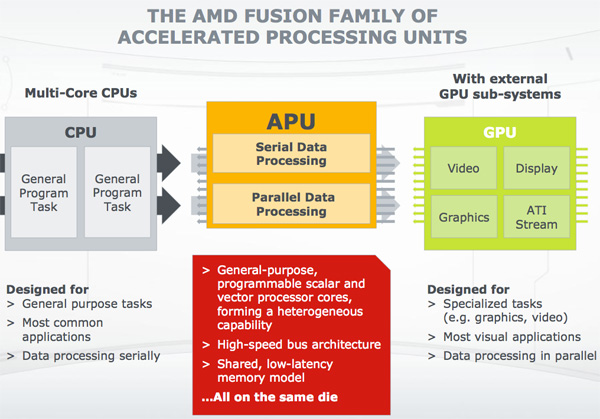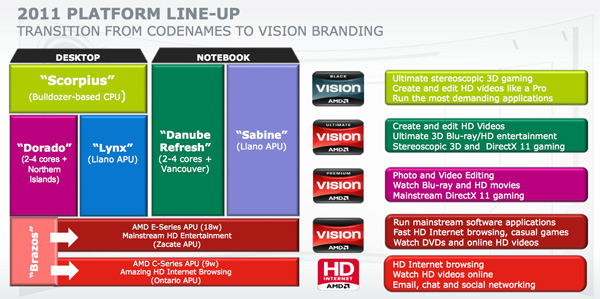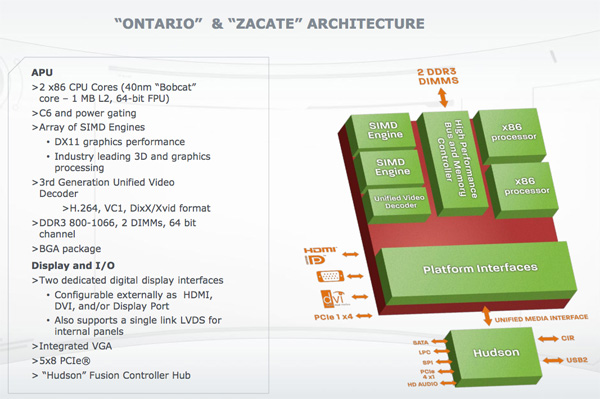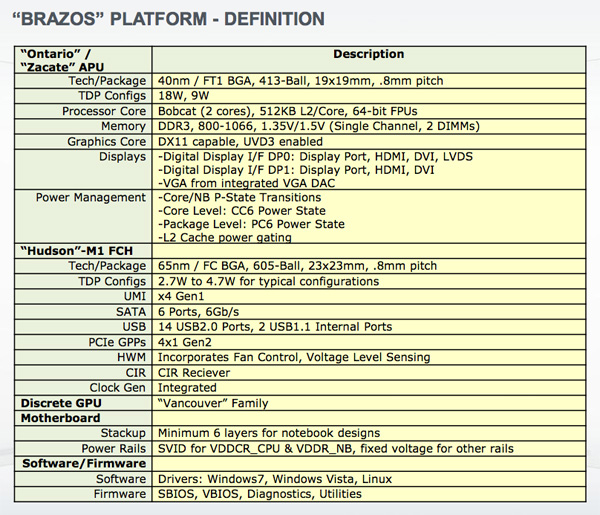Previewing AMD's Brazos, Part 1: More Details on Zacate/Ontario and Fusion
by Anand Lal Shimpi on November 9, 2010 1:09 AM ESTMeet the Brazos
The platform is called Brazos. Brazos encompasses two chips: a Zacate or Ontario APU (Accelerated Processing Unit) and the Hudson Fusion Controller Hub (FCH). This is the whole reason AMD bought ATI, Zacate and Ontario are its first CPU-GPU hybrids.
While AMD is primarily targeting the netbook/ultraportable and notebook markets with Ontario and Zacate (respectively), we’ll also see nettops/desktops and mini-ITX motherboards based on Brazos. This may be the first time we see real competition to NVIDIA’s ION platform.

AMD's Zacate APU, 19mm x 19mm package, 413 balls, 75mm^2 die
Both APUs are built from the same die. Zacate and Ontario are physically identical, they just run at different clock speeds. The 40nm die is manufactured at TSMC and measures 75mm^2. The chip is very cheap to package as well. The BGA package only has 413 balls. As one AMDer put it, these chips are designed to be stamped out as quickly and as cheaply as possible.
Both are available in single and dual core versions, although the single core variant is just a dual-core chip with one core disabled to hit various market segments. Core unlocking is apparently possible, but unexpected given the target for these platforms and the amount of effort OEMs would have to go to in order to enable it.
The CPU cores are based on AMD’s first truly low power client architecture, codenamed Bobcat. We’ve discussed Bobcat in great length already, but at a high level it looks a lot like an out-of-order Atom processor without Hyper Threading. The fundamental architecture advantage should give Bobcat the performance advantage over Atom, at least at identical clock speeds.
The GPU is based on AMD’s 5000 series architecture (Evergreen) and features 80 shader cores and AMD’s new UVD3 decode engine.
The SKUs
At launch you’ll see four SKUs, the combinations and specs are listed below:
| AMD Brazos Lineup | ||||||||
| APU Model | Number of Bobcat Cores | CPU Clock Speed | GPU | Number of GPU Cores | GPU Clock Speed | TDP | ||
| AMD E-350 | 2 | 1.6GHz | Radeon HD 6310 | 80 | 500MHz | 18W | ||
| AMD E-240 | 1 | 1.5GHz | Radeon HD 6310 | 80 | 500MHz | 18W | ||
| AMD C-50 | 2 | 1.0GHz | Radeon HD 6250 | 80 | 280MHz | 9W | ||
| AMD C-30 | 1 | 1.2GHz | Radeon HD 6250 | 80 | 280MHz | 9W | ||
Zacate takes the top two SKUs, while Ontario makes up the bottom two. The difference in TDP is entirely based on the clock speed of the CPU and GPU. And here is my concern. While a pair of Bobcats running at 1.6GHz are just awesome, drop the clock to 1.0GHz and I start getting concerned about performance. AMD didn’t let us test the C-50 but I’m curious to see what the margin of victory will be over Atom at that speed.
The GPU runs at 500MHz at the high end (Radeon HD 6310) and 280MHz at the low end (Radeon HD 6250). This paired with the single channel DDR3-800/1066 memory bus that has to be shared with the Bobcat cores means you should expect sub-5450 levels of performance out of these systems. Given their price point, that’s potentially not too bad. More enticing however is the fact that these APUs gain the benefit of the driver work AMD does on its discrete cards. Finally, game compatibility should be just as good on the low end as it is on the high end - assuming you meet the minimum specs for the title you’re running.
The lack of a brand for the CPU is a bit puzzling, but graphics are where it’s at these days.














106 Comments
View All Comments
iwodo - Tuesday, November 9, 2010 - link
Relatively powerful GPU sounds not very good. If i consider 1 being first gen, 6 would be 6th gen already. Even though some of these are half gen, I would be very sad if a 5 years later Low end GPU cant outplaform my Mid Range from Gfx computer..Shadowmaster625 - Tuesday, November 9, 2010 - link
X1600M looks like a slightly faster nvidia ION. Zacate is definately faster than that. According to the numbers from the preview from 6 weeks ago, it will be about 30% faster.The question is, how close will Ontario be to beating the performance of your X1600M laptop? I bet they will be so close you wont be able to tell the difference.
plonk420 - Tuesday, November 9, 2010 - link
i can't wait to put this in my HTPC!i just hope it can keep up with AnyDVD HD and realtime BD+ decryption...
Setsunayaki - Tuesday, November 9, 2010 - link
True freedom isn't about the actual processor. Its about the performance.If you run windows even under a low performance setting, the system is hurt by the fact one needs to run antiviruses, firewalls, spyware and adware removal tools. It means running Windows with a pair of bobcats + the GPUs are going to have their power spent on keeping those "Security" programs up.
AMD itself can not code a decent Linux Driver to the point performance is going to be shot to hell on Linux.
I'd much rather have a laptop with an nvidia solution running a linux system as it means I get performance since decent nvidia drivers exist on linux, and one doesn't have to run any of the security programs one has to run on Linux and the performance efficiency is a lot higher on Linux.
All what fusion is going to do is increase the level of dependency people have to windows.
jabber - Tuesday, November 9, 2010 - link
All you need is MS Security Essentials and maybe Malwarebytes sitting there dormant as a backup.Dont need anything more.
Shouldnt make any PC sweat.
blowfish - Tuesday, November 9, 2010 - link
That's got to be a joke! Have you ever noticed how MSSE can put a system into a pregnant pause every now and then? Watch the service in Task Manager, for example. On a low powered system, those pauses could be very long, and quite disruptive.MFK - Tuesday, November 9, 2010 - link
I have what I would consider a low powered PC.An AMD 3200+ Athlon 64 Single Core.
1 GB of ram and a Nvidia 7200SE.
I have only MSSE and Zone Alarm installed on Windows 7 for almost a year now.
I have yet to have a problem with virus/spam/pop ups.
Point being: I have not noticed these pregnant pauses you speak of.
:S
jabber - Tuesday, November 9, 2010 - link
I havent seen them. Running it on around 8 of my own PCs (singles to quads). I think I would have seen that by now.Maybe you have something wrong with your PC?
Prosthetic Head - Tuesday, November 9, 2010 - link
AMD/ATI Linux support has actually got a whole lot better in the last year or 2.I've got a 4870 (closed catalyst driver) in my desktop which only ever runs Ubuntu, and an x300 (open 'radeon' driver) in my laptop. They are running well w.r.t both speed and stability.
AMD are also providing specs and some dev time to the open drivers so there is now varying levels of 2D and 3D acceleration working well in the open drivers - which is more than you can say for nVidia.
I have also found that AMD vs Intel performance results are different under linux vs windows (much windows software is compiled using intels ICC and with more optimisation effort for intel processors). AMD generally perform relativity better under Linux (GCC compiler).
Marburg U - Tuesday, November 9, 2010 - link
Large versions of this article's images are unavailable.